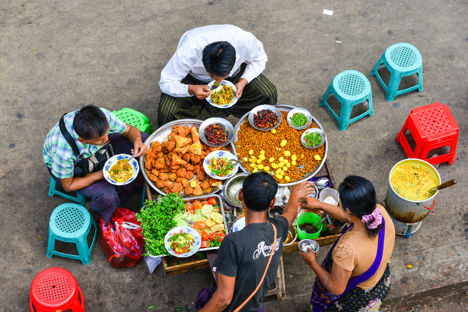
An introduction to Burmese cuisine
MiMi Aye introduces us to the Burmese cuisine of Myanmar, sharing several recipes which showcase the unique flavours, ingredients and textures in the process.
An introduction to Burmese cuisine
MiMi Aye introduces us to the Burmese cuisine of Myanmar, sharing several recipes which showcase the unique flavours, ingredients and textures in the process.
Burmese cuisine is familiar with a twist. It shares influences with its neighbours Thailand, India and China, combining them with techniques, ingredients and flavours of its own to make something distinct and delicious. To use a broad brushstroke, the curries are a little like Malaysian curries, the salads remind one of Thai salads and the noodles are similar to what you’d find in China. Then we have curveballs like tofu made out of chickpeas, curries made with mangoes and salads made from lemons.
Every dish has at least three of the five tastes of salty, sweet, sour, bitter and umami, and every meal has a host of accompaniments. Texture is just as important as flavour, even within the same dish – for example, a bowl of Mandalay Meeshay will have tender rice noodles, crunchy-sour pickles, beansprouts that snap to the bite and meltingly rich morsels of pork.
Key ingredients
Ngapi is our most iconic ingredient. Literally meaning ‘fish pressed’, it's similar to Thai shrimp paste and provides a double whammy of salt and savoury to any dish, and can also be turned into curries, dips and side dishes. Fish sauce is similarly beloved – we rarely use soy sauce.
Dried shrimp is used to provide umami in soups, salads and vegetable dishes – because of this and our love for ngapi, vegetarians are actually quite rare in the country.
Popular for its bittersweet flavour as well as for health reasons, ground turmeric is used to marinate fish or chicken, as a key spice in many curries and is found in chutneys and pickles.
Coriander leaves are used to garnish many Burmese curries, noodles and salads, but we also use coriander stems as an essential part of various curry bases to lend a green, earthy flavour.
Garlic forms part of the Burmese mirepoix along with onions and tomato, but it also crops up in noodle dishes, salad dressings, infused oils, pickles, salsas, and as a fried garnish. Some Burmese garlic is so sweet and mild it's eaten raw as a snack.
Onions may well be our most essential ingredient, as they form the base of almost all our curries, sauces and even many salads; in fact, apparently the Burmese consume more onions per head than any other nation.
Regional variations
The great Irrawaddy river flows through the country, which means freshwater fish is a mainstay everywhere, and the pounded, fermented ngapi mentioned earlier is so prevalent both as a condiment and as an ingredient that it’s even said to run through our veins.
However, Burma is made up of 138 ethnic groups, from the tall and fair-skinned Shan in the mountains, to the giraffe-necked Padaung women and the fearsome, formerly head-hunting Naga on the Indian border, so the food definitely varies, and each region has its own favourites. For example, the Kachin are fond of beef, bamboo shoots and chillies, and in Mogok they're obsessed with pork – a beloved snack is deep-fried pig intestines. Bagan, the land of temples, is renowned for an intense fermented bean paste called pone yay gyi which is served in an onion salad or in a pork curry. Bear in mind that travel connections around Burma have historically been poor, so even where there are common dishes such as pig head salad (Wet-Gaung Thoke), in Mandalay, they will use a base of onions as they're plentiful there, while in Yangon they prefer to use cucumbers.
Must-try dishes
Mohinga is our national dish – a fragrant fish, lemongrass and rice noodle soup usually eaten for breakfast. It’s heaped with crispy split-pea fritters, slices of soft duck egg and bouncy fishcake, then scattered with roasted chilli flakes and shredded coriander leaves. Served with lime or lemon wedges to squeeze on top, it’s a perfect, balanced start to the day. Few people actually make mohinga at home, as there are countless street vendors and cafés vying for business, and everyone has their favourite.
Nan Gyi Thoke (also known as Mandalay Mont Di)is a hearty, warm salad of fat rice noodles, chicken or beef curry, chilli oil, toasted chickpea powder, coriander and sliced shallots.
Lahpet Thoke is probably our most iconic dish– made with pickled tea leaves (lahpet) mixed with crunchy nuts and beans, dried shrimp, sliced tomato and shredded white cabbage to create a piquant and savoury salad, bursting with flavour and textures. This is served at the end of most meals, but is also eaten as a snack or dished out when visitors come round.
Burmese tofu is made from chickpeas, while Shan tofu is made from split peas – neither type is made from the more standard soya beans. You can have our tofu in the form of fritters which are crisp outside and fluffy inside (tohu kyaw), served with a tangy tamarind dip. It’s also sliced up into a salad (tohu thoke) with a piquant dressing, or even served while it’s still warm and molten (tohu nway) over a bowl of spicy noodles.
Talking of fritters, our street food is glorious but our vendors are the absolute best at producing a kyaw (fried snacks), which are light, crunchy and grease-free – gourd fritters, urad dal fritters, prawn fritters, onion fritters, whitebait fritters and of course the tofu fritters mentioned earlier.
Overall though, Burmese food is a feast for the senses – the aroma from a bubbling pot of pork and green mango curry; the vision of a rainbow salad of rice, carrots, and coriander; the crackle and crunch of a handful of split pea fritters; and the sensation of noodles silky with turmeric chicken sauce.


